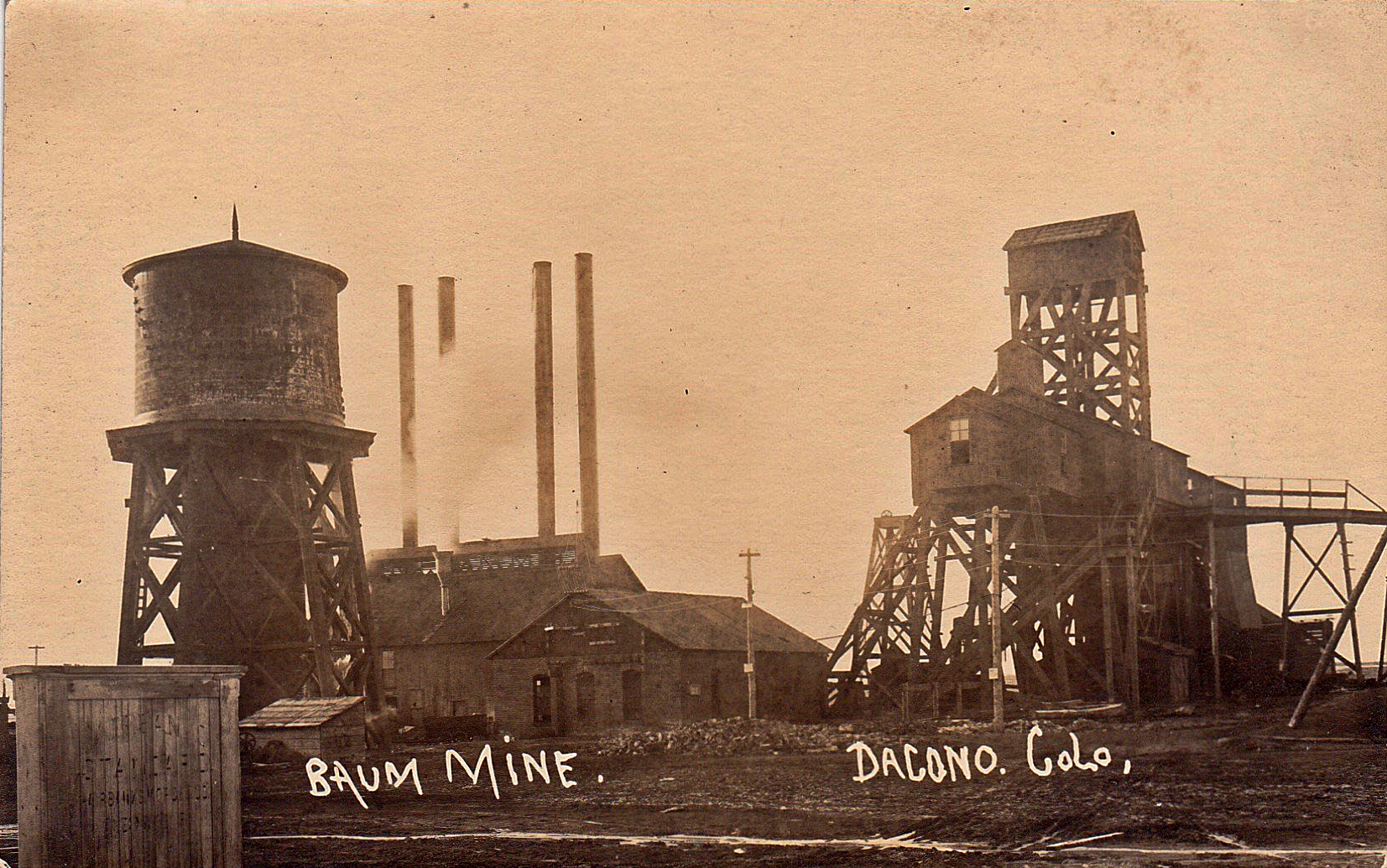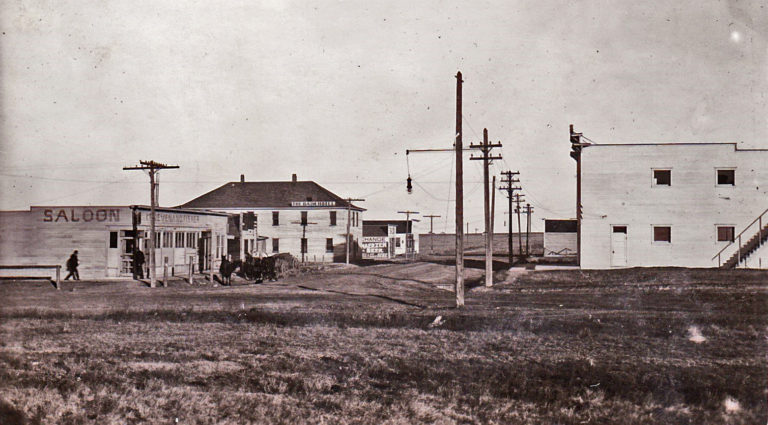This photo postcard shows the Baum “Golden Ash” coal mine. The large structures pictured from left to right are a water tank, power plant (aka “boiler house”) and headframe for the mine shaft. As of 1920, the shaft’s depth was reported to be 200 feet.
In 1901, Charles Lockhard (C.L.) Baum, his wife, Daisy Mary (Davis) Baum, and their daughter, Mabel, moved to Denver from Alameda, California, where C.L. had worked as a hardware salesman. This was not their first move. They had also lived in Nebraska, where Mabel was born, and in Utah. It was in Utah in 1896 that they lost their youngest child, Fanny, who died in January at age 12 from unknown causes. Not 10 months later, their 14-year-old son, Sydney, accidentally drowned while duck-hunting in a boat at Hot Springs Lake.
In 1904 C.L. acquired a section (640 acres) of range land 9 ½ miles northeast of Erie and 7 ½ miles west of Fort Lupton, where he would build his mine, which opened in the fall of 1905. The business was incorporated on October 6, 1906, as the Consolidated Coal and Coke Company, located in Denver, with C.L. as President.
The Baum mine was part of what was known as the Boulder-Weld coal field, which covered a large area northwest and north-northeast of Denver. The first mine in this field was located near Marshall. Coal mining spread from there, becoming successively deeper as it moved in a northeasterly direction toward Frederick. From 1864 until the closing of the last operating mine in 1978, there were 223 coal mines in the district.
Following the establishment of Baum’s mine, a settlement began to grow about a half-mile from the mine, and Baum gave it the name Dacono. It was incorporated on May 21, 1908, with a population of 275. C.L. constructed the town’s name from the first two letters of Daisy’s name and the first two letters of the first names of two of Daisy’s friends, Cora Van Voorhies and Nona Brooks (more about Nona below).
In February 1914, the U.S. Congressional Subcommittee of the Committee on Mines and Mining conducted hearings in Denver to investigate conditions of coal mines in Colorado. C.L. gave testimony at those hearings which provides some interesting details about his mining business and Dacono:
After Dacono was laid out, Baum built 15 houses there, selling 12 of them to miners on monthly payments and, as of the date of the hearing, all but 2 of the 12 had been paid for. He said three of the houses “came back to him,” which he rented for $8 /month. He said he encouraged his workers to own their homes. At the mine he had 6 or 7 bunk houses and a large boarding house, the latter of which he rented out to a couple to manage. In 1910, 50 percent of the men lived in town and the others at the mine. At the time of the hearing, Baum employed 215 men, a number that would decline as the warmer months approached. He reported that 500 people were living in Dacono at the time. On the northeast section of Baum’s property sat the incorporated town of Frederick, and on 80 acres adjoining Frederick was the little unincorporated town of Firestone, comprising about 150 people.
C.L. had no interest in providing a company store. The only things he sold to the men were their tools, caps and powder and other items used in the mine. It appears that he ran two shifts at the mine – a day shift from 8:00 a.m. to 4:00 p.m. and a swing shift from 4:00 p.m. to midnight.
Moving on to Daisy Baum….
After Daisy and C.L. arrived in Denver in 1901, Daisy joined the First Divine Science Church and became a close friend of one of its founders, the aforementioned Nona Brooks. The church espoused the belief that physical ailments could be healed once a person became conscious and fully accepting of the omnipresence of God. Daisy became a teacher, practitioner and writer with the church, serving as the church’s First Vice President in 1916. By then, the church was referred to as the Colorado College of Divine Science. In 1909, she wrote the book “Studies in Divine Science.” To see her book, as well as a picture and short biography of Daisy, go to the following link: http://lessonsintruth.info/library/new-thought-home-study-courses/studies-in-divine-science-by-mrs-c-l-baum/ . As of this writing, her book is also available on Amazon.com.
C.L. died in 1922 and Daisy in 1923. They are buried next to their children Sydney and Fanny at Mount Olivet Cemetery in Salt Lake City.
Subsequent to C.L.’s death, daughter Jenny’s husband, Carson W. Smith, took over as president of the Consolidated Coal and Coke Company.
The most recent reference I could find to the Baum Mine was in the year 1943, when Carson Smith sought out the services of Harold F. Silver, an inventor of some renown in the dry cleaning and sugar beet industries, to automate the digging of coal. Silver came up with a cutting machine dubbed the “Continuous Miner,” which hacked the coal out of the wall, put it on a conveyer belt and dropped it into the coal carts. This machine and its descendants significantly improved coal production capabilities in the industry.
REFERENCES:
- Hearings before a Subcommittee of the Committee on Mines and Mining – U.S. House of Representatives, 63rd Congress, 2nd Session. Making an Investigation of Conditions in the Coal Mines of Colorado — February 9 – 12, 1914.
- City of Dacono at www.ci.dacono.co.us/879/Dacono-History .
- “Colorado Place Names,” 3rd edition, page 49, by William Bright, Google Books at https://books.google.com/books?id=jW3SlDq8JmUC&q=dacono#v=snippet&q=dacono&f=false
- Colorado Geological Survey, “Boulder/Weld Coal Field.” at www.Coloradogeologicalsurvey.Org
- “New Thought Archives” at http://lessonsintruth.info
- Ancestry.com at www.ancestry.com
- “American Mining Manual” dated 1920.
- “Twin Lakes Miner” newspaper (Twin Lakes, CO), issue dated February 17, 1906. www.Coloradohistoricnewspapers.org


